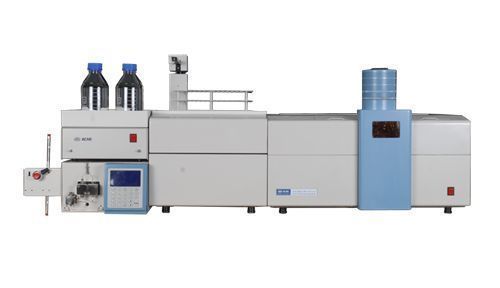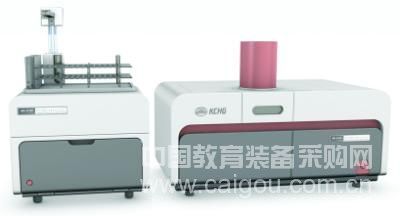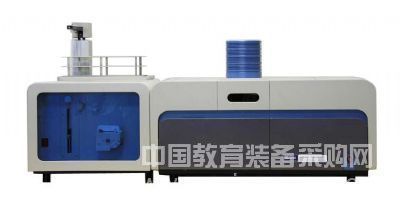China Education Equipment Purchasing News: Atomic fluorescence spectroscopy is an analytical method developed after 1964. Atomic fluorescence spectrometry is an emission spectrometry method that quantitatively analyzes the fluorescence intensity emitted by atoms under the excitation of radiant energy. But the instrument used is similar to atomic absorption spectroscopy. Atomic fluorescence spectrometry has a high sensitivity, a wide linear range of calibration curve, and simultaneous multi-element determination. Atomic fluorescence spectroscopy is a spectrum analysis technology between atomic emission spectrum and atomic absorption spectrum. Its basic principle is that the ground state atoms (general vapor state) absorb appropriate radiation of a specific frequency and are excited to a high energy state, and then emit fluorescence with characteristic wavelengths in the form of optical radiation during the excitation process. Atomic fluorescence spectroscopy (AFS) is a spectrum analysis technique between atomic emission spectroscopy (AES) and atomic absorption spectroscopy (AAS). Its basic principle is that the ground state atoms (general vapor state) absorb appropriate radiation of a specific frequency and are excited to a high-energy state, and then emit fluorescence with characteristic wavelengths in the form of optical radiation during the excitation process. Description: A method for measuring the fluorescence intensity of the atomic vapor of the element under test excited by radiant energy of a certain wavelength for quantitative analysis. The wavelength of atomic fluorescence is in the ultraviolet and visible regions. After the gaseous free atom absorbs the radiation of the characteristic wavelength, the outer electron of the atom transitions from the ground state or low energy state to the high energy state. After about 10-8 seconds, it transitions to the ground state or low energy state again, and emits fluorescence at the same time. If the wavelength of atomic fluorescence is the same as the wavelength of the absorption line, it is called resonance fluorescence; if it is different, it is called non-resonance fluorescence. The resonance fluorescence intensity is large, which is the most used in the analysis. Under certain conditions, the resonance fluorescence intensity is proportional to the concentration of an element in the sample. The advantage of this method is that it has high sensitivity. At present, the detection limit of more than 20 elements is better than atomic absorption spectroscopy and atomic emission spectroscopy; the spectrum is simple; the linear range of the calibration curve is wide at 3 to 5 at low concentrations Order of magnitude, especially when laser is used as excitation light source. It is mainly used for the determination of metal elements and has a wide range of applications in environmental science, high-purity substances, minerals, water quality monitoring, biological products, and medical analysis. Resonance atomic fluorescence After being excited by atomic absorption radiation, it then emits radiation of the same wavelength, producing resonant atomic fluorescence. If the atom is in a metastable state by thermal excitation, it is further excited by absorbing radiation, and then resonant fluorescence of the same wavelength is emitted. This kind of resonance atomic fluorescence is called thermally assisted resonance atomic fluorescence. Such as In451.13nm is an example of this type of fluorescence. Only when the ground state is a single state, there is no intermediate level, and no other type of fluorescence is generated from the same excited state at the same time, can the resonance atomic fluorescence be generated. Non-resonant atomic fluorescence When the radiation wavelength of the excited atoms is different from the fluorescence wavelength emitted by the excited atoms, non-resonant atomic fluorescence is generated. Non-resonant atomic fluorescence includes straight jump line fluorescence, step line fluorescence and anti-Stokes fluorescence, Straight line fluorescence is the fluorescence emitted when the excited state atoms directly transition to a metastable state higher than the ground state, such as Pb405.78nm. Only when the ground state is a multiple state can the straight jump fluorescence be produced. Step-line fluorescence is the fluorescence emitted by an excited state atom which is first deactivated in a non-radiative manner to return to a lower excited state, and then deactivated by radiation to return to the ground state; It is excited by heat to a high energy state, and then deactivates the fluorescence emitted by returning to a low energy state by radiation. The former step line fluorescence is called normal step line fluorescence, such as Na589.6nm, and the latter step line fluorescence is called thermally assisted step line fluorescence, such as Bi293.8nm. Anti-Stokes fluorescence is that the wavelength of the emitted fluorescence is shorter than the wavelength of the excitation radiation, such as In 410.18nm. Sensitized atomic fluorescence Excitation atoms transfer their excitation energy to another atom by collision to excite it, and the latter is deactivated by radiation to emit fluorescence. This fluorescence is called sensitized atomic fluorescence. The atomic concentration in the flame atomizer is very low, and it is mainly deactivated by non-radiation, so no sensitized atomic fluorescence is observed. The advantages of atomic fluorescence spectroscopy: (1) There is a lower detection limit and high sensitivity. In particular, Cd, Zn and other elements have a relatively low detection limit, Cd can reach 0.001ng · cm-3, Zn is 0.04ng · cm-3. There are now more than 2O elements below the detection limit of atomic absorption spectroscopy. Since the radiation intensity of atomic fluorescence is proportional to the excitation light source, the use of a new high-intensity light source can further reduce its detection limit. (2) There is less interference and the spectrum is relatively simple. With some devices, a non-dispersive atomic fluorescence analyzer can be made. This instrument is simple in structure and cheap in price. (3) The analysis calibration curve has a wide linear range, which can reach 3 to 5 orders of magnitude. (4) Since atomic fluorescence is emitted in all directions in space, it is relatively easy to make multi-channel instruments, so that multiple elements can be measured simultaneously. Instrument construction Atomic fluorescence analyzer is divided into non-dispersive atomic fluorescence analyzer and scattered atomic fluorescence analyzer. The structure of these two types of instruments is basically similar, the difference lies in the monochromator part. The optical path diagram of the two types of instruments is shown on the right: 1. Excitation light source: continuous light source or sharp line light source can be used. Commonly used continuous light sources are xenon arc lamps, and commonly used sharp line light sources are high-intensity hollow cathode lamps, electrodeless discharge lamps, and lasers. The continuous light source is stable, easy to operate, and has a long life. It can be used for simultaneous analysis of multiple elements, but the detection limit is poor. The sharp line light source has high radiation intensity and stability, and can get better detection limit. 2. Atomizer: The requirements of the atomic fluorescence analyzer on the atomizer are basically the same as the atomic absorption spectrometer. 3. Optical system: The function of the optical system is to make full use of the energy of the excitation light source and receive useful fluorescent signals to reduce and remove stray light. The dispersive system does not have high requirements for resolving power, but requires a large collection power. The commonly used dispersive element is a grating. The filter of the non-dispersive instrument is used to separate the analysis line and the adjacent spectral line to reduce the background. The advantages of the non-dispersive instrument are large illumination solid angle, spectral bandwidth, large light collection ability, high fluorescence signal intensity, simple instrument structure and convenient operation. The disadvantage is that the influence of scattered light is large. 4. Detector: The photomultiplier tube is commonly used. In the multi-element atomic fluorescence analyzer, the photoconductive image tube and the image tube are also used as detectors. The detector is arranged at a right angle to the excitation beam to avoid the influence of the excitation light source on the detected atomic fluorescence signal. The following are several instruments of different types of atomic fluorescence series: AFS-9700 automatic injection pump atomic fluorescence photometer LC-AFS9800 liquid chromatography atomic fluorescence spectrometer AFS-9900 automatic four-channel cyanide generation atomic fluorescence photometer AFS-9780 automatic four-position lamp position injection cyanide generation atomic fluorescence photometer (Xie Yinan / Editor)
We provide one stop shop for project, all your barbecuing needs and offer a large range of Grill Tools and Accessories for cooking, cleaning and maintenance. With our selection of BBQ accessories you have everything to prepare,
cook and clean your BBQ.
The Grill Accessories including BBQ Tool sets, Grill Rotisserie Kit, BBQ Motor, Grill Gas Burner, Grill
Cooking Grate, Heat Shield, Cast Iron Grid, Rotisserie
Basket, Baking Set, Pizza Stone Kit, Pizza Peel, Charcoal Starter, etc.
Grilling Tools,Heat Plate,Grill Cooking Grates,Gas Valve Dongguan Jiangxin Metal Products Co., Ltd , https://www.jiangxinbbq.com



How is fluorescence spectroscopy applied?